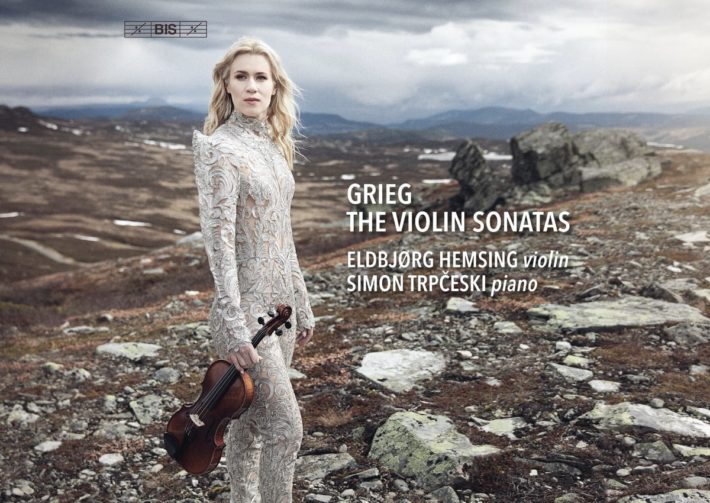There is a large gap between Grieg’s first 2 Violin Sonatas and the Third, written 20 years later. Composed when Grieg was 22 (1865), the First Sonata is idyllic and optimistic, and we see him trying to reconcile classical form with unique and nationalist language. Hemsing and Trpčeski present a fine performance with a narrative character: the music takes a descriptive, almost visual quality, thanks to their striking musicality. The pianist’s first movement opening consists of only two chords, but in that short span he is able to create a real sense of mystery. The violinist opens just as imaginatively, with her energetic, almost breathless playing that reflects the youthfulness of the writing.
Hemsing has a rare, diaphanous sound quality which complements well the whimsical character of the first Sonata. But that is not to say that she plays everything softly or gently; where there needs to be power or passion, her playing is full and declarative. The second movement shows her technical abilities, though not merely in a virtuosic sense: her remarkable bow control results in an impeccable clarity, that still allows the instrument to take on different personalities. Trpčeski’s control is just as good: there is not a moment where the violin is overpowered, yet we are aware of his presence at all times through his deep and resonant playing. The third movement is a delight: where the violin is buoyant and even dreamy, the pianist shines with stellar articulation and balance. The attention to synchronicity is also worthy of note: there are many intricate passages in this movement, and you’d scarcely find notes that do not come together perfectly.
Where the First Violin Sonata is youthful, the Second from 1867 offers a more complex and contemplative side to the composer. There is a central theme of contrast, which is introduced straightway: upon hearing the wistful and romantic opening, we do not expect the emergence of the bright G major section. This element of surprise keeps the listener engaged in the unfolding of the movement. The contrast also shows the duo’s versatility: we seem to hear two very different personalities of the performers in the sections of bounding energy or deep meditation, which adds to the vibrance of their interpretation.
The second movement is characterized by nuance: from the start, there are many shades of dynamics. Despite the subtlety of Grieg’s writing, the performers play with a lovely fluidity. Hemsing’s lines are particularly supple: she organically pushes phrases forward and holds them back. The subtle glissando at 0’36” is a beautiful addition to an opening that already gives a vocal quality to her lines. One challenge lies in its compositional structure: the existence of distinct sections of different thematic material and character, which can make the movement sound segmented. Here the performers handle this very well by considering an overarching structure, creating unity through a consistently refined sound quality. The third movement, with its dance-like lilt and strong folk character, is a strong finish: the duo’s virtuosity is on display here and makes for an exciting listen.
Related Classical Music Reviews
- Review: Denis Kozhukhin Plays Grieg And Mendelssohn
- Review: Grieg – Peer Gynt, Piano Concerto – Bavouzet, Gardner
- Review: Vilde Frang and Michail Lifits Play Paganini and Schubert
The final Sonata was not written until two decades after the second and took Grieg a much longer time to complete. In it, we can hear more of his own personal idiom, as opposed to the folk elements that played a prevalent role in his earlier sonatas. Mystery and suspense, perhaps even conflict, are central ideas here. Sections of the first movement feature the violin at a much lower register, and we hear how Hemsing effectively uses this change in timbre to showcase a more dramatic and ominous side of the instrument. Again, Trpčeski exhibits excellent control, but there are climactic moments where I wished for his playing to be a little more “unhinged,” as it might have added a rawness and enhance the movement. Yet the second movement has some of the pianist’s most beautiful playing on the album and is easily the best of this work: the opening solo is nothing short of breathtaking, with its bell-like tone and lyricism. Both performer’s sensitivities reach a high point here, and it is hard not to become fully immersed in the music.
The album concludes with one of Hemsing’s own solo compositions, a variations on a folk tune from Valdres, also used in Grieg’s Ballade for piano. Highlighting her flawless technique, it is a fitting complement to the musicality she established in the Grieg sonatas.
The sound engineering is excellent, especially in terms of its balance, with the listener able to clearly hear (and appreciate) the strong performances of both artists. This is true to the SACD and CD formats of this album, released as a single “Hybrid SACD”. This album is a must-listen.

Grieg – Complete Violin Sonatas (1-3)
Hemsing – Homecoming (2019)
Eldbjørg Hemsing – Violin
Simon Trpčeski – Piano
BIS Records, Hybrid SACD BIS-2456
Grieg Violin Sonatas – Recommended Comparisons
Read more classical music reviews or visit The Classic Review Amazon store
Follow Us and Comment:
Get our periodic classical music newsletter with our recent reviews, news and beginners guides.
We respect your privacy.









